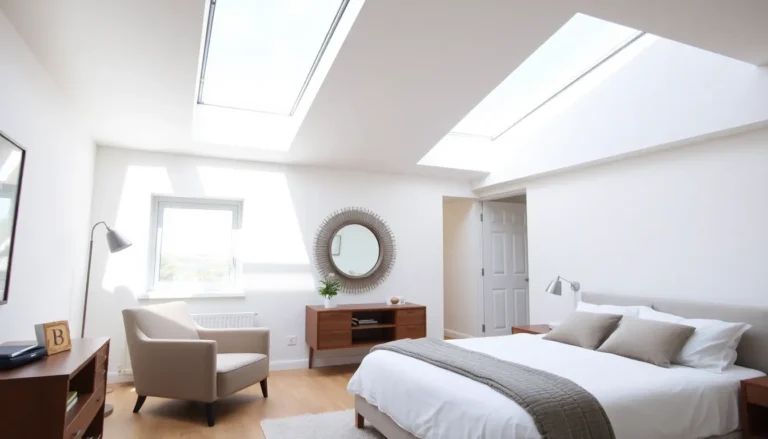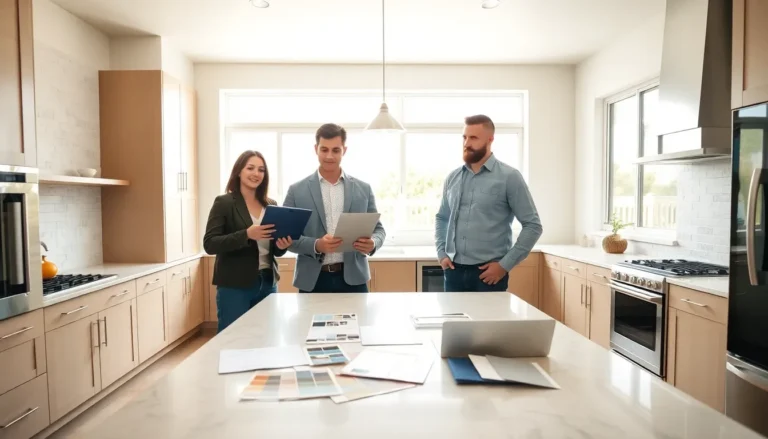Home improvement loans might just be the secret sauce to turning that drab living room into a Pinterest-worthy paradise. Whether it’s finally tackling that leaky roof or giving the kitchen a facelift, these loans can help homeowners unleash their inner renovation guru without breaking the bank.
Table of Contents
ToggleWhat Is Home Improvement Loan?
A home improvement loan provides homeowners with funds to renovate or enhance their properties. These loans cover various projects, ranging from minor updates to major renovations. They often come in two main types: secured and unsecured.
Secured loans require collateral, such as the home itself. They usually offer lower interest rates due to this security. Unsecured loans, however, do not require collateral and often come with higher interest rates. Homeowners can choose based on their financial needs and credit profiles.
Many lenders offer different terms and repayment options. Typical repayment periods range from five to 30 years. Homeowners can borrow amounts depending on equity in their homes, project costs, and creditworthiness. Current loan amounts typically fall between $2,000 and $100,000.
Using a home improvement loan serves multiple purposes. It allows for essential repairs like roofing or plumbing, energy-efficient upgrades, or full-scale remodels. Some projects may even increase property value, benefiting resale potential.
Interest rates fluctuate based on economic conditions and borrower credit scores. Homeowners with higher credit scores generally enjoy more favorable rates. Additionally, comparing multiple lenders helps secure the best terms.
Application processes vary by lender but often require basic financial information. Documentation usually includes proof of income, credit history, and project details. Gathering these materials ahead of time simplifies the process and speeds up approval.
Types of Home Improvement Loans
Home improvement loans can fall into two primary categories: secured and unsecured. Both options cater to different financial situations, helping homeowners find the right fit for their renovation projects.
Secured Loans
Secured loans require collateral, such as the home itself. This type of loan typically offers lower interest rates due to reduced lender risk. For instance, homeowners can use equity from their property to secure financing. Loan amounts generally reach $100,000 or more, supporting extensive renovations. Repayment terms often range from five to 30 years, with flexibility depending on lender preferences. Borrowers, however, must remain cautious since defaulting on a secured loan could lead to property forfeiture.
Unsecured Loans
Unsecured loans don’t require collateral, making them accessible for those without significant home equity. These loans usually come with higher interest rates compared to secured options. Borrowers can typically obtain amounts ranging from $2,000 to $50,000, sufficient for minor updates or smaller remodels. Repayment periods vary, often spanning three to 10 years. Approval hinges largely on creditworthiness, meaning a strong credit score can improve borrowing conditions. Even with higher rates, unsecured loans provide flexibility and ease of access when funds are needed quickly.
Eligibility Criteria for Home Improvement Loans
Eligibility for home improvement loans often hinges on specific financial criteria. Homeowners typically need to meet requirements related to credit scores and income verification.
Credit Score Requirements
Lenders favor borrowers with strong credit scores. A score above 600 frequently qualifies for many unsecured loans. Secured loans may require an even higher score, often above 700, to access better terms. It’s crucial to note that higher credit scores generally lead to lower interest rates. Consequently, borrowers looking to improve their scores should focus on timely payments and reducing debt.
Income and Employment Verification
Lenders insist on proof of income to ensure borrowers can repay the loan. Full-time employment demonstrates stability, which is often required for approval. Self-employed individuals might need additional documentation, such as tax returns or business statements. Typically, lenders expect to see steady income over at least two years. This verification process helps assess the borrower’s ability to manage loan repayments, making it an essential part of the application.
Benefits of Home Improvement Loans
Home improvement loans provide valuable financial support for renovations, enabling homeowners to enhance their living spaces. These loans offer several advantages that make them an appealing option for many.
Increased Property Value
Home improvement loans contribute to increased property value after renovations. Updating kitchens or bathrooms often yields higher returns on investment, attracting potential buyers. Essential repairs like roof replacements can prevent future issues and enhance longevity, maximizing home resale potential. Energy-efficient upgrades further appeal to environmentally conscious buyers, leading to higher offers. Homeowners typically see a return ranging from 70% to 90% on investments for well-planned renovations. Thus, a home improvement loan serves not only immediate needs but also supports long-term financial goals.
Low-Interest Rates
Low-interest rates frequently accompany secured home improvement loans, making them an economical choice for borrowers. These loans generally require collateral, which allows lenders to offer more favorable terms. Borrowers with strong credit scores often secure rates below 4%, resulting in significant savings over the loan term. Unsecured loans usually feature higher rates due to increased risk for lenders, often reaching 10% or more. Homeowners who shop around for lenders can find competitive rates, ensuring that their loan remains manageable throughout the repayment period. Accessing low-interest loans helps homeowners complete their renovation projects affordably.
How to Apply for a Home Improvement Loan
Applying for a home improvement loan involves a few straightforward steps. Homeowners should focus on gathering necessary documentation to facilitate the process.
Preparing Your Application
Collecting key documents makes applying for a home improvement loan smoother. Proof of income, credit history, and details about the planned renovation project are vital. Lenders often require two years of income verification to assess financial stability. Preparing a detailed budget for the renovation can strengthen the application, showcasing financial responsibility. Having credit reports ready allows homeowners to identify and correct any inaccuracies before submission. These proactive measures enhance the chances of approval.
Choosing the Right Lender
Selecting the ideal lender significantly impacts loan outcomes. Research multiple lenders to compare interest rates, terms, and fees. Each lender has unique requirements and offerings, making it crucial to find one that aligns with personal financial situations. Reading reviews and seeking recommendations can reveal valuable insights. A lender with experience in home improvement loans may offer favorable terms or specialized options. Prioritizing lenders who provide transparent communication ensures a smoother borrowing experience.
Home improvement loans offer a practical way for homeowners to finance their renovation projects. By understanding the different types of loans available and their respective benefits, homeowners can make informed decisions that align with their financial goals. Whether opting for a secured or unsecured loan, careful consideration of terms and interest rates can lead to significant savings.
Investing in home improvements not only enhances living spaces but can also boost property value. With proper planning and a clear budget, homeowners can transform their visions into reality. By approaching lenders with the right documentation and a solid understanding of their financial position, they can navigate the application process smoothly and secure the funding needed for their projects.





